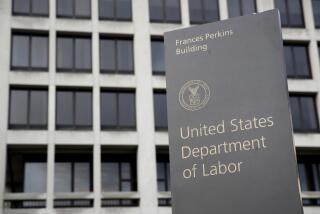Cost of bailout could double
The White House on Thursday raised the prospect that the price tag for bailing out the financial system could more than double to nearly $1.5 trillion.
President Obama’s fiscal 2010 budget outline, released Thursday, warns that, should economic conditions worsen, an additional $750 billion could be required on top of the $700-billion rescue fund authorized by Congress last fall.
“We hope that it will not be necessary,” Peter R. Orszag, director of the Office of Management and Budget, said of increasing the bailout fund. “We have no plans to go to Congress at this point to ask for additional money.”
Highlighting the industry’s problems, the government reported Thursday that banks and savings institutions insured by the Federal Deposit Insurance Corp. collectively incurred a net loss of $26.2 billion in the last three months of 2008, the first such quarterly loss since 1990.
Obama’s budget outline for the fiscal year beginning Oct. 1 also calls for greater spending on oversight of the financial markets, with budget increases of 13% for the Securities and Exchange Commission and 44% for the Commodity Futures Trading Commission. In addition, the outline says more money would be provided to the Justice Department to investigate mortgage fraud and other financial activities, although an exact amount isn’t specified.
Some lawmakers have called for boosting regulatory enforcement efforts, particularly at the SEC, which has been sharply criticized for failing to identify Bernard L. Madoff’s alleged Ponzi scheme.
SEC chief Mary L. Schapiro said the additional money for the agency in the fiscal 2010 budget would allow it to increase its staff and use new technology “to pursue risk-based approaches that would better detect fraud and ensure stronger oversight of the nation’s securities markets.”
But the main focus of the government’s response to the financial crisis continues to be stabilizing the banking industry. The Treasury Department on Wednesday began so-called stress tests of the nation’s largest banks to assess whether they could survive two more years of harsh economic conditions.
Such a worse-than-expected scenario was behind the decision to include the “contingency reserve” in the budget.
Analysts expressed little surprise that the cost of the bailout might top $1 trillion, in part because some of the money has been used for other purposes, such as assisting automakers and reducing home foreclosures.
“You just look at how quickly the government went through the first $350 billion. . . . Look at the scale of the problems in the financial sector now,” said Brad W. Setser, an economist at the Council on Foreign Relations. “I think it’s probably in the ballpark of what’s needed.”
About $387 billion of the $700-billion Troubled Asset Relief Program has been committed to financial institutions and automakers. The Obama administration also has announced it will use $50 billion from the fund to reduce home foreclosures.
But Setser said the government stood to recoup much of the bank-rescue costs at some point. Obama administration officials reflected that in their budget outline.
The contingency reserve is listed in the budget outline as a $250-billion expense because the government estimates it will get back about two-thirds of the money it spends to acquire assets from financial institutions.
Still, if the White House does seek the additional $750 billion, the request is likely to face trouble in Congress.
Many lawmakers have been highly critical of how the first half of the $700-billion rescue fund was spent. Obama secured access to the second half only by promising more transparency and oversight of how banks used the money.
But Sen. Judd Gregg (R-N.H.), who complained about the tax increases and spending in Obama’s budget outline Thursday, said he was open to the possibility that more money might be needed for the financial rescue.
“We’re in such a difficult fiscal situation that if they come to us and make a legitimate case that in order to stabilize this economy and specifically the financial sector, they need more TARP dollars. . . . I’m certainly going to be listening,” he said.
--







